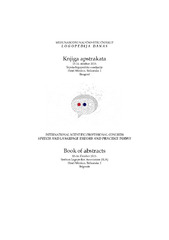Приказ основних података о документу
Neuropsihološki deficiti kod dece i adolescenata sa traumatskom povredom mozga
Neuropsychological deficits in children and adolescents with traumatic brain injury
| dc.creator | Vuković, Mile | |
| dc.date.accessioned | 2023-10-30T09:49:26Z | |
| dc.date.available | 2023-10-30T09:49:26Z | |
| dc.date.issued | 2023 | |
| dc.identifier.isbn | 978-86-904830-1-3 | |
| dc.identifier.uri | http://rfasper.fasper.bg.ac.rs/handle/123456789/5299 | |
| dc.description.abstract | Uvod: Traumatska povreda mozga se relativno često događa u populaciji dece i adolescenata. To je inače najčešći tip stečene lezije mozga u detinjstvu. Može da se dogodi u bilo kom periodu, s tim što su deca uzrasta do dve godine i adolescenti od 15-18 godina najčešće žrtve moždane traume. Traumatska povreda mozga predstavlja jedan od vodećih uzroka neuropsiholoških poremećaja i prekida toka normalnog razvoja kod dece. U ovom radu razmatrani su poremećaji pažnje, pamćenja, jezika, egzekutivnih funkcija i socijalne kognicije. Cilj: Cilj nam je da pružimo sveobuhvatan prikaz neuropsiholoških deficita kod dece i adolescenata koji su pretrpeli traumatsku povredu mozga. Metode: Za pretragu relevantne literature korišćene su specijalizovane baze podataka i pretraživači, pomoću ključnih reči na srpskom i engleskom jeziku. Rezultati: Opisani su znaci i simptomi kognitivnih poremećaja u odnosu na težinu povrede i uzrast na kome je ona nastala. Istaknute su posledice rano stečene povrede mozga na razvoj kognicije i psihosocijalno funkcionisanje. Takođe, opisane su metode procene kognitivnih funkcija i pristupi u rehabilitaciji dece sa kognitivnim poremećajima uzrokovanim traumom mozga. Zaključak: Povreda mozga u detinjstvu i adolescenciji dovodi do prolaznih i dugoročnih kognitivnih i bihevioralnih poremećaja. Iako se dugoročni neuropsihološki deficiti mogu ispoljiti i kod blage povrede mozga, oni se tipično sreću kod dece i mladih sa teškom povredom. Pojava traumatske povrede u detinjstvu zahteva sistematsko praćenje i uključivanje dece i mladih sa neuropsihološkim posledicama u proces rehabilitacije i druge vidove podrške. | sr |
| dc.description.abstract | Introduction: Traumatic brain injury occurs relatively often in the population of children and adolescents. It is also the most common type of acquired brain lesion in childhood. It can happen at any time, the most common victims of brain trauma being children under the age of two and adolescents aged 15-18. Traumatic brain injury is one of the leading causes of neuropsychological disorders and disruption of normal development in children. In this paper, disorders of attention, memory, language, executive functions and social cognition are discussed. Aim: Our goal is to provide a comprehensive overview of neuropsychological deficits in children and adolescents who have suffered a traumatic brain injury. Method: Using keywords in Serbian and English, specialized databases and search engines were used to find relevant literature. Results: We describe the signs and symptoms of cognitive disorders in relation to the severity of the injury and the age at which it occurred. The consequences of early acquired brain trauma on the development of cognition and psychosocial functioning are emphasized. We also describe methods of assessing cognitive functions and approaches to the rehabilitation of children with cognitive disorders caused by traumatic brain injury. Conclusion: Brain injury in childhood and adolescence leads to transient and long-term cognitive and behavioural disorders. Although longer-term neuropsychological deficits can also occur with mild injury, they are typically found in children and youth with severe brain injury. The occurrence of traumatic brain injury in childhood requires systematic monitoring and inclusion of children and young people with neuropsychological consequences in the rehabilitation process and other types of support. | sr |
| dc.language.iso | en | sr |
| dc.publisher | Srpska logopedska asocijacija | sr |
| dc.relation | info:eu-repo/grantAgreement/MESTD/Basic Research (BR or ON)/179068/RS// | sr |
| dc.rights | openAccess | sr |
| dc.rights.uri | https://creativecommons.org/licenses/by/4.0/ | |
| dc.source | Book of abstracts | sr |
| dc.subject | neuropsihološki poremećaji | sr |
| dc.subject | traumatska povreda mozga | sr |
| dc.subject | deca | sr |
| dc.subject | adolescenti | sr |
| dc.subject | neuropsychological disorders | sr |
| dc.subject | traumatic brain injury | sr |
| dc.subject | children | sr |
| dc.subject | adolescents | sr |
| dc.title | Neuropsihološki deficiti kod dece i adolescenata sa traumatskom povredom mozga | sr |
| dc.title | Neuropsychological deficits in children and adolescents with traumatic brain injury | sr |
| dc.type | lecture | sr |
| dc.rights.license | BY | sr |
| dc.citation.spage | 17 | |
| dc.identifier.fulltext | http://rfasper.fasper.bg.ac.rs/bitstream/id/10764/bitstream_10764.pdf | |
| dc.identifier.rcub | https://hdl.handle.net/21.15107/rcub_rfasper_5299 | |
| dc.type.version | publishedVersion | sr |


